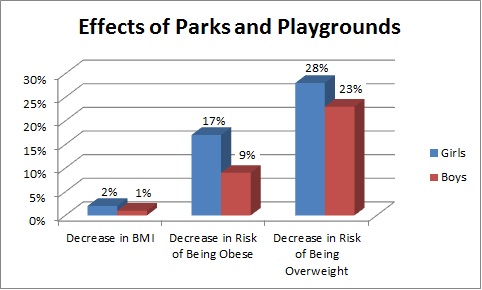Fan, Maoyong, and Yanhong Jin. “Can neighborhood parks and playgrounds help fight childhood obesity?” Oxford University Press. 18 September 2013. Web. 5 Feb 2016.
The national childhood obesity rate has been rising for years in all communities. In this article, Maoyong Fan and Yanhong Jin discuss the correlation between the presence of neighborhood parks and childhood obesity and how the built environment can be used to positively affect the physical health of children. In their findings, the pair concluded that neighborhoods with parks and playground had lower childhood obesity rates than those that did not.
Several other aspects also affect this simple conclusion. Income, ethnicity, and safety are all contributing factors in whether or not families use their local parks. For example, low-income families rely more on public resources but are sometimes deterred from using them due to the lack of safety.

Fan, Maoyong, and Yanhong Jin. “Parks-and-Playground-Chart.jpg.” Oxford University Press, September 18, 2013. http://blog.oup.com/wp-content/uploads/2013/09/parks-and-playground-chart.jpg.
Because of this, the authors suggest that using community safety resources like police and volunteers to maintain parks can provide a safe haven for kids, and therefore, promote and improve physical health. Using the information and suggestions in this article, simple steps can be made in fighting childhood obesity.
After analyzing this source, I have noticed a correlation in the readings. Most articles focus on the negative effects of the built environment. In this article, we are shown how the built environment can be used to affect our lives to our advantage and improve health.
Galea, Sandro, Jennifer Ahern, Sasha Rudenstine, Zachary Wallace, and David Vlahov. “Urban Built Environment and Depression: A Multilevel Analysis.” J Epidemiol Community Health. 59. (2005): 822-827. Web. 3 Feb 2016.
This article focuses on the association between the qualities of the urban neighborhood built environment and depression. When you search the web for the built environment, countless sources analyzing the built environment’s effect on the physical health of its residents come up. The authors of this article decided to instead study the effect on mental health. By conducting a random digital dial telephone survey in metropolitan NYC, they were able to find a correlation. Residents of neighborhoods with poorer features, such as a corrupt or unstable justice system, poor quality schools, and more exposure to violence and trauma, were more likely to report 6-month and lifetime depression (Galea 825).
They came to the conclusion that there are three primary explanations for this finding. The psychological stress explanation states that living in a poor quality neighborhood leads to psychological stress, making residents more susceptible to depression. Daily hassles in densely populated urban neighborhoods amplify the strain on the mental health of occupants. The second explanation is the concentrated disadvantage point, which states that qualities of the built environment also shape mental health. For example, the absence of greenery in a neighborhood has been associated with poor mental health. The social drift conclusion suggests that people with poor mental health are more likely to move to poor quality neighborhoods.
While this data seems reliable, there is one aspect that I believe might have created a flawed result. This study was conducted in the NYC area in the aftermath of the September 11th, 2001 terrorist attack that shocked the world and killed thousands. From common knowledge and personal experience, I know that this time was one of heightened sadness, anxiety and depression due to the tragedy and this may have skewed the results.
Leyden, Kevin M. “Social Capital and the Built Environment” The Importance of Walkable Neighborhoods.” American Journal of Public Health. 93.9 (2003): 1546-1551. Web. 3 Feb. 2016.
This article by Kevin Leyden addresses how the built environments of communities are made to either promote or discourage the socialization and community engagement. Pedestrian-oriented, mixed-use neighborhoods are arranged so that local businesses and places of worship were near and accessible to residents by sidewalk.

Gated Communities only encourage interaction within the community. | “Overview.jpg (JPEG Image, 566 × 422 Pixels) – Scaled (75%).” SonsDevelopment LLC, 2013. http://www.sonsdev.com/wp-content/uploads/2014/10/overview.jpg.
This structure allows occupants to interact and can, “help to encourage a sense of trust and a sense of connection between people and the places they live” (Leyden 1546). Modern suburban neighborhoods tend to rely much less on the idea of a walkable community. Shopping, restaurants, medical offices, and other establishments are often hard to get to without a car due to a lack of sidewalks, several lanes of highways, and far distances. By organizing a community where people are restricted to transportation by car, these suburban subdivisions do not enable community engagement.
The concept of the built environment shaping the lives of its residents is reminiscent of Nersessova’s evaluation of Morton’s photography of the underground homeless of New York City. Also, the differences between pedestrian oriented Downtown Atlanta and suburban Metro Atlanta are also represented in this article. Georgia State University students interact with their campus, city, and peers in a way that families in suburban neighborhoods cannot due to their built environment’s restrictions on community engagement.